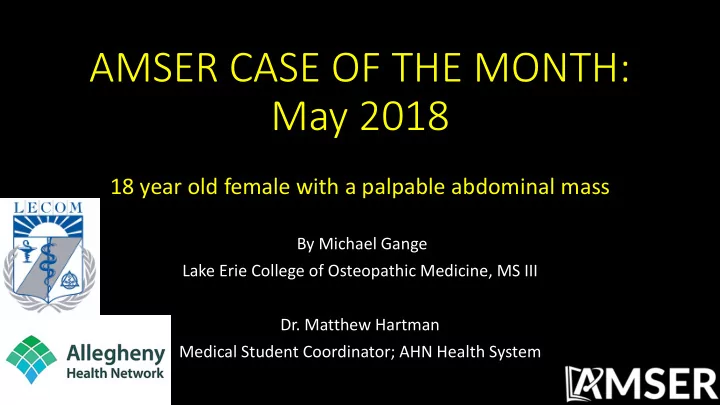

AMSER CASE OF THE MONTH: May 2018 18 year old female with a palpable abdominal mass By Michael Gange Lake Erie College of Osteopathic Medicine, MS III Dr. Matthew Hartman Medical Student Coordinator; AHN Health System
Patient Presentation • CC/HPI: 18 year old female presented to her pediatrician for a sports physical. She stated that she has felt something in her abdomen for the past three years, but has not gotten it checked out because it hasn’t really bothered her. The only other symptoms she has had are occasional abdominal pain and right flank pain. • Targeted physical exam: Large nontender right sided mass • Medical Hx: none • Past Surgical Hx: none • Past Medications: none
Differential Diagnosis Prior to Imaging: • Ovarian mass • Uterine mass • Hepatomegaly • Renal mass What type of imaging would you order next?
ACR Appropriateness Criteria for a Palpable Abdominal Mass This was the first imaging ordered for her symptoms.
CT Scan Results
Large pelvic mass demonstrating three different First mass visualized at a tissues types: calcium (^), fat lower level. (*), and fluid (#). # * U ^ ^ A second mass located posterior to the uterus (U). Large mass creates mass effect on the surrounding bowel. Note the calcifications (^).
The Reason for Her Right Flank Pain… Notice how the left There is right sided kidney is excreting hydronephrosis and appropriately during the hydroureter with delayed * pyelographic/delayed excretion of contrast phase. related to mass effect from the right sided pelvic mass.
The Surgery and Pathology Report • The patient underwent surgery for these masses. She had a left oophorectomy and a cystectomy of her right ovary. • The pathology report stated that the left mass was a high grade immature teratoma with admixed foci of yolk-sac tumor while the right mass was a mature cystic teratoma (also known as a dermoid cyst). • These results were sent to Johns Hopkins for confirmation.
The Patient’s Treatment for Teratomas • The patient had undergone a PET-CT to rule out any metastasis and began 3 cycles of chemotherapy using cisplatin and etoposide as well as weekly bleomycin. • She began to have symptoms of pulmonary toxicity after the second week of bleomycin and did not receive any in the third week. • The patient successfully completed her chemotherapy and today is healthy and symptom free for the past two years. • Oophorectomy is usually curative for benign teratomas. • This patient wanted to preserve her fertility so a conservative approach was taken to treat her right adnexal mass.
Ovarian tumors • There are three types of ovarian tumors: epithelial, germ cell, and stromal. • Teratomas are a form of germ cell tumor. • Females are more likely to have a benign teratoma than males. • Malignant teratomas are most likely to occur in the first two decades of life, while benign teratomas are more likely to occur in the second and third decades. • Treatment of benign teratomas is typically an oophorectomy. • The standard treatment for a malignant teratoma is surgery follow by chemotherapy consisting of bleomycin, etoposide, and cisplatin if it is a high grade malignancy. • Human chorionic gonadotropin (HCG), alpha fetoprotein (AFP), and lactate dehydrogenase should be measured prior to starting chemotherapy and used to monitor the response.
Radiologic Findings • Ultrasound will show a complex adnexal mass, but these findings are nonspecific. • CT scans will typically show a large heterogeneous mass with areas of different density/Hounsfield units. • Tissues can include skin, fat, muscle, nervous tissue, hair, and teeth. • There are some teratomas that are predominantly cystic though. • Immature teratomas may metastasize to the peritoneum, lung, liver, and brain.
References • https://www.cancer.org/cancer/ovarian-cancer/treating/germ-cell- tumors.html • https://acsearch.acr.org/list/GetEvidence?TopicId=131&TopicName=P alpable%20Abdominal%20Mass • https://radiopaedia.org/articles/immature-ovarian-teratoma • https://radiopaedia.org/articles/mature-cystic-ovarian-teratoma • https://www-uptodate-com/contents/ovarian-germ-cell-tumors- pathology-clinical-manifestations-and-diagnosis
Recommend
More recommend